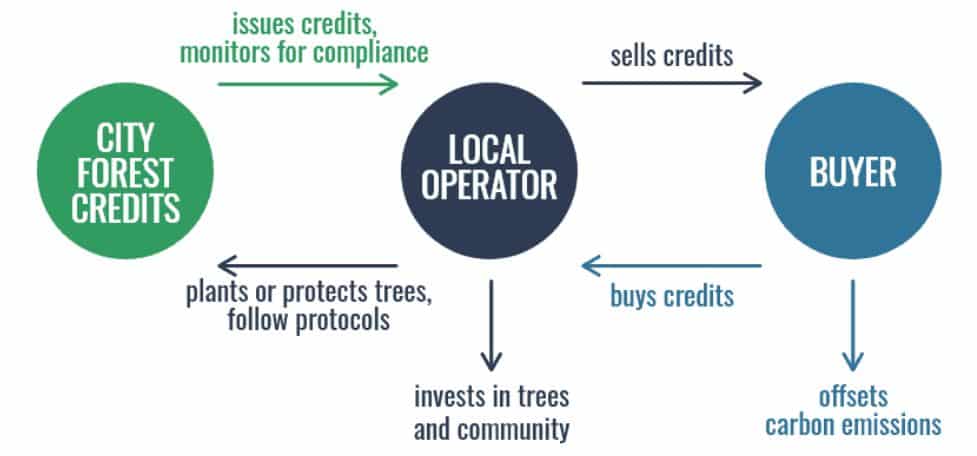Cities and companies start to recognize how investing in trees is beneficial after the biggest single urban forest carbon credits purchase in US history.
A group of 13 organizations and government entities made a first-of-its-kind deal that bought all the city forest carbon credits available in the U.S.
Their urban forestry projects earned a total of over $1 million. The revenues will go back to supporting tree planting and management programs.
The landmark deal supports projects that are in communities reaching over 20 million Americans. The pilot projects were in Austin, Texas, and King County.
Market players said that the rising price of urban forest carbon credits shows that buyers are recognizing the immense value and benefits of city or urban forests.
What are Urban Forest Carbon Credits?
A carbon credit is a tradable permit that represents CO2 (or any equivalent greenhouse gas) removed from the atmosphere. A polluter can then buy the credit to offset or neutralize its carbon emissions.
Forestry-related carbon credits are one of the common offset options available in the market today. Yet, some climate activists criticize them for allowing big firms to greenwash.
But urban forest carbon credits are a more novel option. Many people believe their benefits offer a fresh and different kind of value that is more than just protecting trees.
They also help improve the quality of air and mental health of the population residing in the cities. These benefits contribute to the much higher price of the credits compared to global forest carbon credits.
According to Regen Network, the price per credit was between $34 – $45 per metric ton of CO2.
In contrast, the price for global forest credits can be lower than $10 per credit.
As for Kathleen Farley Wolf, manager of King County Forest Carbon Program:
“That price is really a signal that these kinds of projects are highly valued and that there’s recognition that doing urban forest projects is expensive; cities are expensive, suburbs are expensive.”
With the recent rise in corporate net zero pledges, the demand for urban forest carbon credits will also grow as projected by the City Forest Credits (CFC).
CFC is a registry organization based in Seattle that manages, promotes, and issues urban forest carbon credits. It’s a non-profit organization dedicated solely to urban forest carbon. It developed carbon protocols for tree planting and tree preservation projects in cities and towns.
The protocols set rules governing specifics like the location and duration of a project and how the carbon will be quantified.
-
These new credits are exclusive for the urban environment and the unique challenges and possibilities it has. And so they differ from traditional carbon credits.
The price and negotiation process occurs between the credit buyer and local operator. This is how this carbon credit program works:
Buyers can buy verified carbon credits directly from local operators to offset their emissions and bring more trees for communities.
Carbon Capture with Urban Forests
Between 2010 and 2060, urban land is estimated to increase another 95.5 million acres to 163.1 million acres (8.6%). Also, 18 states are projected to have an increase of over 2 million acres.
Urban forests, like any forests, help address climate change by capturing and storing CO2. They also help heat and cool buildings.
In the US alone, urban trees store over 708 million tons of carbon. This is equal to about 12.6% of annual CO2 emissions in the country.
Urban forests also capture an additional 28.2 million tons of carbon (0.05% of annual emissions) annually.
More interestingly, the value of urban forest carbon sequestration is huge. That’s around $2 billion per year with a total carbon storage value of more than $50 billion.
Potential for Market Growth
The potential of urban forest carbon credits in both fighting climate change and benefiting cities is huge. But there are also some barriers to beat for this carbon credit program to grow. These include:
- limited awareness of urban forests and their ability to offer carbon credits,
- a lack of binding requirements to participate, and
- local governments’ minimal capacity to grow such programs
Yet, the widely recognized benefits of urban forests can be a catalyst for attracting more investments. For instance, extreme heat and poor air quality are going to make the credits even more valuable and bankable.
Right now, participation in this carbon credit market remains voluntary. But more climate commitments from companies and governments can help propel market growth.
As per Jad Daley, CEO of American Forests:
“Urban forests stand at the center of carbon removal, social equity, public health, biodiversity, and positive community impacts where millions of people live, work, breathe, and recreate… These credits are a critical step toward financing equitable city forests for everyone.”
The urban forest carbon credits aim to quantify not only the carbon capturing benefits of urban trees. They also include rainfall interception, energy savings from cooling and heating effects, and air-quality benefits.



